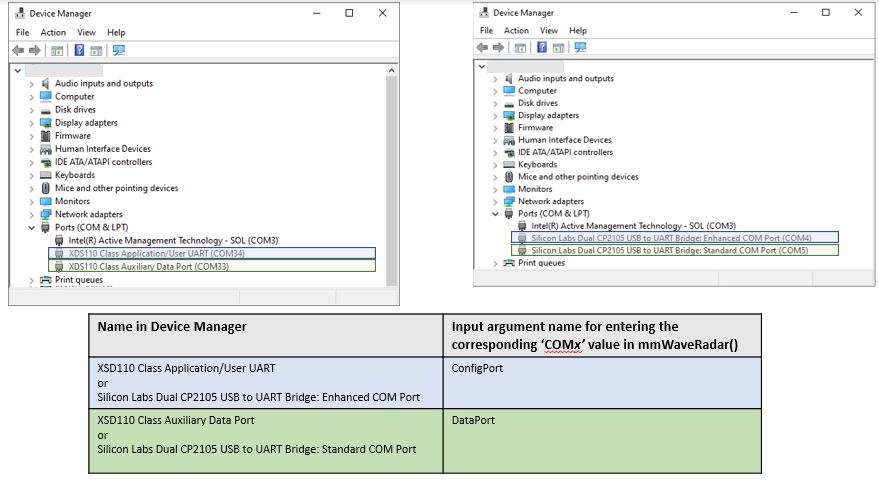Identifying Serial Ports for TI mmWave Radar Connection
You may need to identify the serial (COM) port on the host computer to which the TI
mmWave radar is connected, while you perform setup using Hardware Setup window or while you
create mmWaveRadar or dca1000 objects in MATLAB.
If you have only one TI Radar connected, MATLAB usually tries to auto-detect the ports associated with TI mmWave radar. If you have multiple TI mmwave radars connected or if MATLAB is unable to auto-detect the COM port (you get error related to COM port on mmWaveRadar or dca1000 object creation or Hardware Setup is not listing or listing multiple COM ports in the respective screens), you can manually identify the ports using the below information.
TI mmWave radar uses two ports for configuration - Config port and Data port.
You can use Device Manager (or the equivalent application for your operating system) to
find the configuration and data ports. In the Device Manager window, expand the
Ports (COM & LPT) list.
The configuration port is usually named
Silicon Labs Dual CP2105 USB to UART Bridge: Enhanced COM PortorXDS110 Class Application/User UART.The data port is usually named
Silicon Labs Dual CP2105 USB to UART Bridge: Standard COM PortorXDS110 Class Auxiliary Data Port.

Additionally, when you create the mmWaveRadar object or
dca1000 object, you can use the MATLAB Tab completion feature to view
the available configuration ports.
For example, while creating a mmWaveradar object, type this command in
the MATLAB Command Window and press the Tab key after "=" to view the available ports for
ConfigPort:
tiradar = mmWaveRadar("TI IWR6843ISK", ConfigPort =While creating a dca1000 object, type this command in the MATLAB
Command Window and press the Tab key after "=" to view the available ports for
ConfigPort:
dca = dca1000(“IWR6843ISK”, ConfigPort =
Note
dca1000 object creation to read raw ADC data requires the Config
port only, and not the Data port.